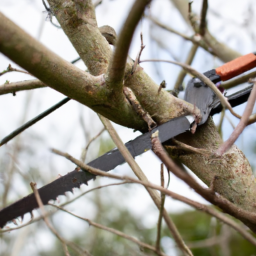So, you’ve got yourself a manual pole saw, huh? Well, get ready to tackle those hard-to-reach branches and keep your yard looking pristine. In this article, we’ll explore the nitty-gritty of using a manual pole saw, covering everything from proper handling techniques to maintenance tips. Whether you’re a seasoned gardener or a DIY enthusiast, we’ve got you covered with all the information you need to make the most out of your new tool. Let’s get started and unleash your inner tree-trimming superhero!
Choosing a Manual Pole Saw
When it comes to choosing a manual pole saw, there are a few key factors you need to consider. The first is the length of the pole saw. Longer pole saws are ideal for reaching higher branches, while shorter ones may be more suitable for smaller trees or shrubs. It’s important to evaluate the weight of the pole saw as well. You want a tool that is sturdy and easy to maneuver without causing strain or fatigue. Lastly, check the blade type. Different blade types are designed for specific purposes, so choose one that matches the type of cutting you’ll be doing.
Preparation and Safety Measures
Before you start using your manual pole saw, there are a few essential preparation and safety measures to keep in mind. First and foremost, inspect the pole saw. Check for any damage or signs of wear and tear that could interfere with its performance or compromise your safety. Next, make sure to wear protective gear, such as safety goggles, gloves, and a hard hat, to shield yourself from any potential hazards during operation. Lastly, survey the work area. Look out for any obstacles, power lines, or uneven terrain that could pose a risk while using the pole saw.
Using a Manual Pole Saw
Properly using a manual pole saw involves mastering a few techniques. Firstly, position the pole saw correctly. Keep a comfortable distance from the branch you want to cut, making sure you have a clear line of sight. Next, grip the pole saw firmly but without straining your hand or arm. Find a comfortable swinging technique and remember to use your body’s strength rather than relying solely on your arm muscles. Finally, use the cutting technique recommended for your specific pole saw model. Follow the instructions provided by the manufacturer for the best and safest results.
Cutting Different Types of Branches
Depending on the size and thickness of the branches you’re dealing with, you’ll need to adjust your cutting technique accordingly. For small branches, a quick and controlled swipe with the pole saw should be sufficient. However, for medium-sized branches, you may need to use a slightly more substantial swing or make multiple cuts at different angles to ensure a clean break. When it comes to large and thick branches, a combination of strategic cuts and leverage may be necessary. Be patient and take your time to avoid any accidents or damage to the tree.
Maintenance and Care
To keep your manual pole saw in optimal working condition, regular maintenance and care are essential. Start by cleaning the blade after each use. Remove any debris or sap buildup that may affect the saw’s performance. Be careful not to use harsh chemicals that could damage the blade. Additionally, it’s important to sharpen the blade regularly. A dull blade can make cutting more difficult and potentially dangerous. Lastly, check and replace any worn-out or damaged parts as needed. This will ensure that your manual pole saw maintains its efficiency and longevity.
Common Mistakes to Avoid
When using a manual pole saw, there are a few common mistakes that you should avoid. The first is neglecting to inspect the pole saw before each use. Failing to do so may result in using a faulty tool that can endanger your safety or lead to inefficient cutting. Another mistake is using incorrect technique. It’s crucial to follow the recommended techniques for your specific pole saw, as using improper form can not only be less effective but also increase the risk of accidents. Lastly, neglecting maintenance can significantly impact the performance and lifespan of your pole saw, so make sure to prioritize regular care.
Benefits of Using a Manual Pole Saw
Using a manual pole saw offers several benefits that make it an attractive option for DIY tree care. One of the key advantages is convenience and portability. Manual pole saws are lightweight and easy to transport, allowing you to tackle branches in different areas of your property effortlessly. Additionally, manual pole saws are economically and environmentally friendly. They don’t require electricity or gas, saving you money on utility bills and reducing your carbon footprint. Lastly, using a manual pole saw offers improved safety compared to other methods, as you have better control over the cutting process.
Alternative Options to Manual Pole Saw
While manual pole saws are versatile and efficient, there are a few alternative options worth considering. Electric pole saws are powered by electricity and offer the advantage of effortless cutting without the need for manual strength. Gas-powered pole saws provide even more cutting power and are ideal for heavy-duty tasks. However, both of these options require a power source and can be louder and heavier than manual pole saws. Another alternative is hiring professional tree services. This option is suitable for those who prefer to leave the job to the experts or have extensive tree care needs.
Frequently Asked Questions
Can a manual pole saw cut through thick branches? Yes, a manual pole saw can cut through thick branches, but it may require more effort and the use of proper technique. Be prepared to make multiple cuts and use leverage to break larger branches effectively.
What type of tree branches can be cut with a manual pole saw? A manual pole saw is suitable for cutting small to medium-sized tree branches. It can handle branches that are a few inches in diameter. For larger and thicker branches, alternative methods or tools may be necessary.
Is a manual pole saw suitable for beginners? Absolutely! A manual pole saw is a great tool for beginners due to its simplicity and ease of use. Just make sure to follow the safety guidelines, practice proper techniques, and start with smaller branches until you gain confidence and experience.
Conclusion
Choosing a manual pole saw requires considering factors such as length, weight, and blade type, and proper preparation and safety measures are crucial before using the tool. Mastering the correct positioning, gripping, and cutting techniques is essential for efficient operation. By being aware of the different cutting techniques for branches of various sizes, you can achieve clean and safe cuts without damaging the tree. Regular maintenance, avoiding common mistakes, and understanding the benefits and alternatives are key to maintaining the longevity and effectiveness of your manual pole saw. Whether you’re a beginner or a seasoned DIY enthusiast, a manual pole saw offers a convenient, economical, and safe solution for your tree care needs.



